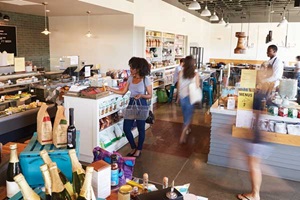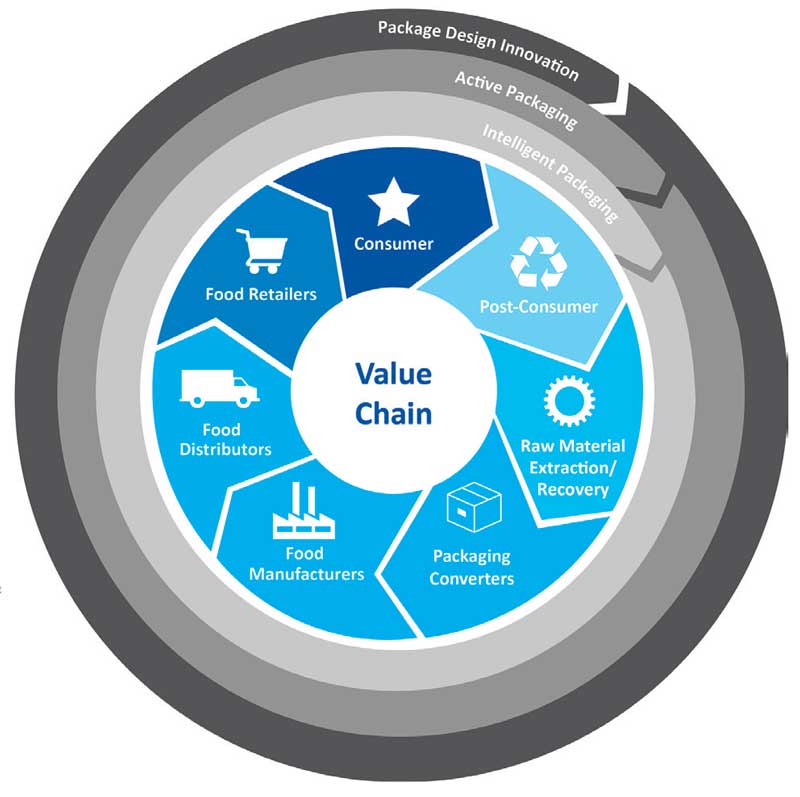The Future of Food Packaging Is Personal
PACKAGING
Future package design and development promise more personalization to bridge the gap between consumer needs and product reality. Consumers want food to meet their unique and changing needs. Producing personalized products is a challenge for large and small food companies. Innovative package design and development can help brands meet the challenge. Personalization is also being achieved with advances in intelligent and active packaging that resonate in the value chain interface of manufacturing, distributing, and retailing.
Enabling Personalization
In manufacturing environments, personalization is often perceived as impossible since package designs and equipment focus on high-speed production. Advancements in package design have proven that this is not true and that the manufacturing process can be more agile to yield product personalization. For example, innovative package designs allow the addition of ingredients in distribution centers. In highly urbanized areas such as Mexico City, manufacturers ship concentrates to intermediate manufacturing centers where stock ingredients such as water and oil are added. Packaging design that allows for tweaking formulas makes personalization possible.
Reusable packaging is also an area ripe for personalization through more agile manufacturing. A reassessment of reusable packaging in direct contact with food has been motivated by new stresses in global recycling economics coupled with increased urbanization and refined capabilities at distribution centers. Innovation in package design is needed to ensure food safety and retain package properties to facilitate the initial fill and refill of reusable packaging. Reusable package designs and materials allow containers to be collected and refilled just outside urban areas, increasing efficiencies, and lowering costs. Research on multiple use, contact time, and temperatures is being revisited and containers are being made more chemically resilient to allow for reuse. Materials such as steel, aluminum, and glass that are inherently resilient to many flavors and odors have promise. Nanosized coatings of these materials on polymers permit more container forming options and lower material costs. Hygienic package design for ease of cleaning is moving to the forefront of package design. These design and manufacturing agility innovations are fueling the use of reusable packaging in a circular economy.
Distribution centers are stimulating package design innovation. Package design that conveys freshness and is conducive to small formats, e-commerce, and the next generation of meal delivery adds value to distribution and the consumer-retailer interface. Distribution centers generate pop-up kiosks that wheel off trucks into retail or act as standalone stores. Kiosk areas are product-specific, selling items such as pizza and containing numerous ingredient options for pizza, including parbaked pizza crusts, sauce, fresh ingredients, and spices. Package design for kiosks and small stores such as Indian kiranas demands ingenuity.
 Retail competition is fierce. Innovation in packaging design facilitates retailer-derived product personalization that can motivate consumers to switch retailers. There are opportunities in many categories to rethink the function of packaging and its design. One example is in the crowded yogurt category. The challenge in the yogurt category is to revitalize easily, continually, and profitably to meet changing consumer needs. By moving formulation and packaging of the yogurt from the manufacturer to the retailer, immediate response to consumer needs is possible. This demand shifts within the value chain. An in-store yogurt machine to package yogurt containing consumer-selected ingredients meets this need. Rotary machines fill and seal yogurt cups with consumer specified amounts of an array of ingredient selections.
Retail competition is fierce. Innovation in packaging design facilitates retailer-derived product personalization that can motivate consumers to switch retailers. There are opportunities in many categories to rethink the function of packaging and its design. One example is in the crowded yogurt category. The challenge in the yogurt category is to revitalize easily, continually, and profitably to meet changing consumer needs. By moving formulation and packaging of the yogurt from the manufacturer to the retailer, immediate response to consumer needs is possible. This demand shifts within the value chain. An in-store yogurt machine to package yogurt containing consumer-selected ingredients meets this need. Rotary machines fill and seal yogurt cups with consumer specified amounts of an array of ingredient selections.
Moving the selection of ingredients in yogurt to the retailer has other benefits beyond enabling consumers to personalize their food. The texture of crunchy ingredients (such as granola) and the probiotic count of the yogurt can be maintained when ingredients are combined closer to consumer consumption. Package design innovation for retailer-consumer handling is different than that required in the more extensive manufacturer-distributor-retailer-consumer network.
Retailer-derived meal kits are another opportunity for package design innovation. Retail assembly of meal kits containing multiple packaged components often results in double packaging since the component packaging is not designed to be part of a meal kit. In addition, many prepackaged chilled meals have a short shelf life and poor quality perception and require a high barrier as well as processing to lower microbial loads. Innovative package design provides a better consumer experience. For example, when an entrée containing uncooked beef stew meat is sealed off next to an open space for the retailer to add fresh vegetables and spices, a complete varied meal can be sold to consumers. Retailers guide meal choices through elegant package design. This is especially pertinent to consumers who have the desire but lack the experience needed to prepare new meals with unfamiliar ingredients. Precooked meals at retailers generally serve a high economic bracket. So packages designed for affordable precooked packaged meals for consumers with budgetary and cooking constraints are needed.
Connecting the Value Chain
Intelligent packaging to integrate and communicate value from manufacturing, distribution, and the retail-consumer interface to the consumer is at the forefront of package development. Packaging provides access to an array of opportunities. While intelligent packaging has been used for branding and marketing, expanding its use to link consumer sales and production is ideal for personalization. Operational efficiency is high in many manufacturing environments and the focus is on high-volume production. But manufacturing packaged foods that are sold to consumers up to 24 months later does not always align well with up-to-the-minute consumer needs. For example, barbecue sauce packaged in February for the entire grilling season will likely not align to the hottest consumer microtrends occurring during summer and early fall. To address this, intelligent packaging gathers consumer information to guide manufacturing needs. While retailers often buy product and stock up on a deal, this is because value is in volume. Moving the value (in the value chain) from volume to personalization aligns better with consumer needs. More value is gained when the link between retail sales and production is consumer-driven versus volume-driven. Intelligent packaging tracks consumer use and purchasing and drives production.
Intelligent packaging also adds value to the distribution handoff from food manufacturers to retailers and in the retailer-consumer interface. Before grocery stores became the norm, food wagons distributed products such as meats and cheeses and product-specific shops sold food to consumers. When large grocery stores and club stores attracted consumers, packaging was designed to facilitate food being sold in these venues. Now, new alternate food sources such as e-commerce, pop-up stores, and meal kits are giving way to the next generation of immediate complete meals delivered from satellite kitchens. With this new type of food source, there are often par-cooked side dishes, enabling meals to be rapidly personalized and finished off within a consumer’s kitchen. Intelligent packaging to track and trace will add value by increasing efficiencies, food safety, and personalization, which are essential within this convoluted distribution network. This is especially essential for food safety. For example, time temperature integrators (TTIs) used in the delivery of microwave-assisted thermal sterilization chilled meals to consumers provide the assurance that optimal preparation, temperature, and time parameters are maintained for food safety accountability at distributors and retailers. This adds value to the process of personalization because without TTIs, the condition of the product is unknown and the product loses value. For consumers, an array of consumer-specific information is accessed through intelligent packaging. For example, ingredient sources, nutrient information, preparation directions, and pairing ideas are all accessible with the swipe of a smartphone or similar device. Intelligent packaging can also be used to rapidly inventory donations, track cold-chain donations, construct meal solutions for clients, make more targeted donation requests, and reduce food losses.
Intelligent packaging that provides even more consumer value is on the way. One tactic that intelligent packaging employs to add value to a consumer’s desire for personalized information is to provide data for wrist fitness trackers and to guide package disposal. Scanning intelligent packaging records nutrient data. The Sustainable Packaging Coalition’s How2Recycle label helps guide package disposal by providing information on whether a package is recyclable or nonrecyclable. Intelligent packaging goes a step beyond this guide to track the amount of packaging that has been recycled, reused, or become garbage by each consumer. The amount of specific plastic, glass, metal, paperboard in the post-consumer environment each consumer generates is tracked. In this process, manufacturers and post-consumer handlers gain information to drive the circular economy and increase recycling and reuse efficiencies. This adds value by enabling consumers to understand their impact on the environment and a more connected circular economy.
Future Packaging Development
Active packaging is packaging that interacts with the food. Adding the capabilities of active packaging to intelligent packaging inspires future package development efforts. The focus of active packaging is food-package interactions, which can be used for personalization from manufacturer to the consumer. There is much potential for food-package interactions to permit high-volume production while manufacturing more personalized products. Work on polymer migration and factors governing diffusion and desorption are refined with mathematical models. Polymers and paper used in packaging act as carriers for flavors, nutrients, bioactive agents, and so on. More commonly, a base product interacts with the packaging as contact time or temperature increases to form a variety of products. This can extend the shelf life of products as well.
 Claire Koelsch Sand, PhD, Contributing Editor
Claire Koelsch Sand, PhD, Contributing Editor
CEO, Packaging Technology and Research
Adjunct Professor, Michigan State Univ. and
California Polytechnic State Univ.
[email protected]


